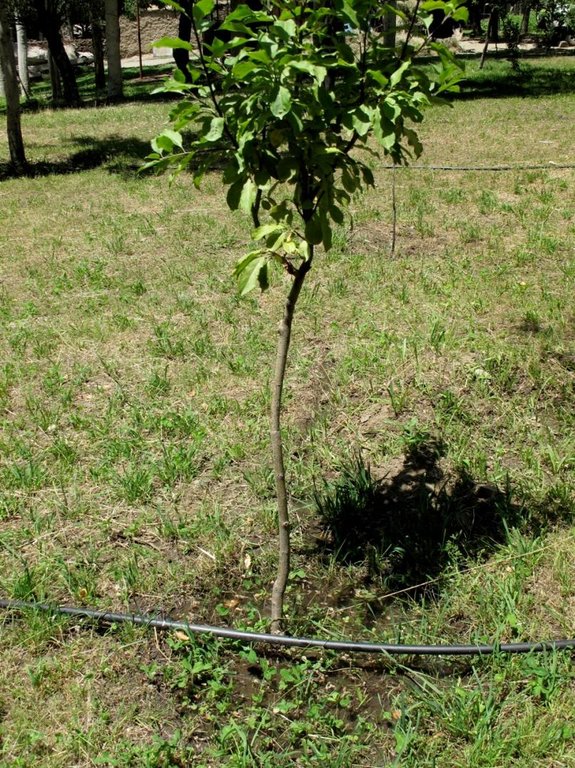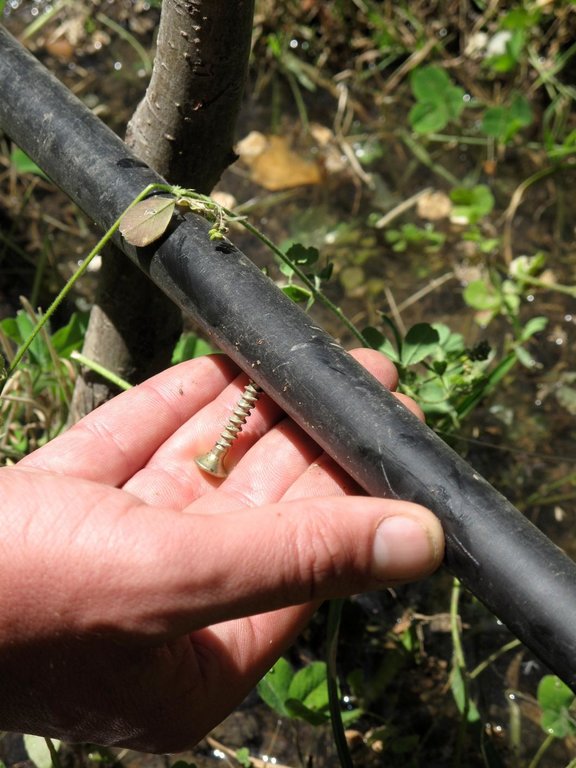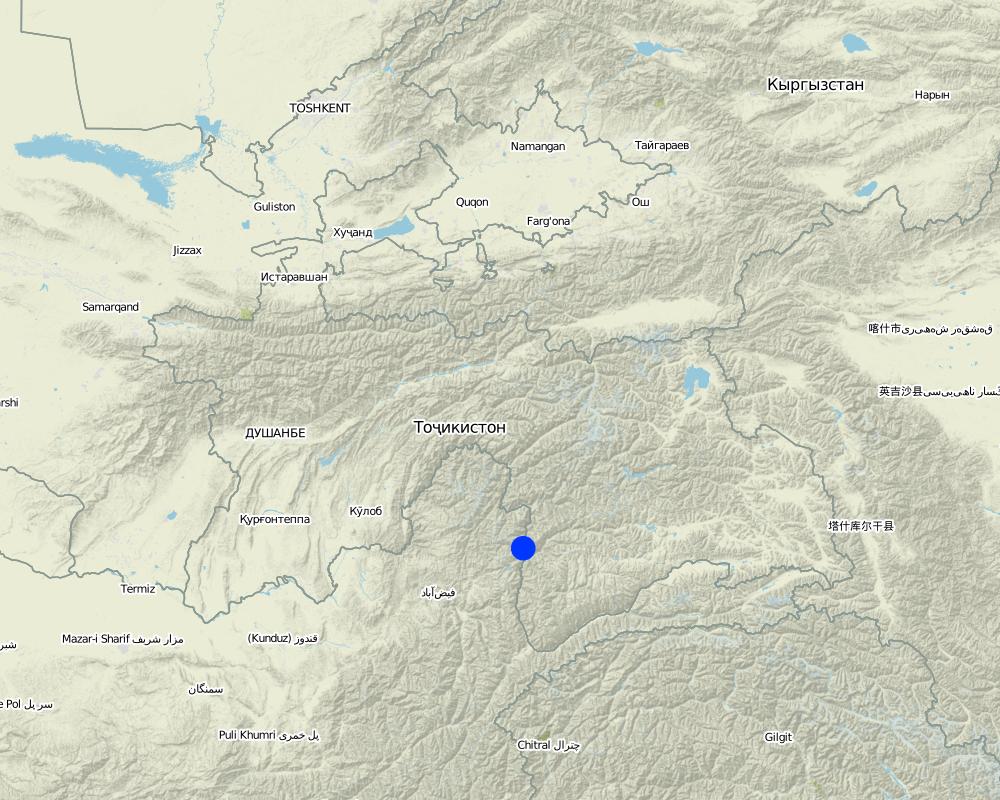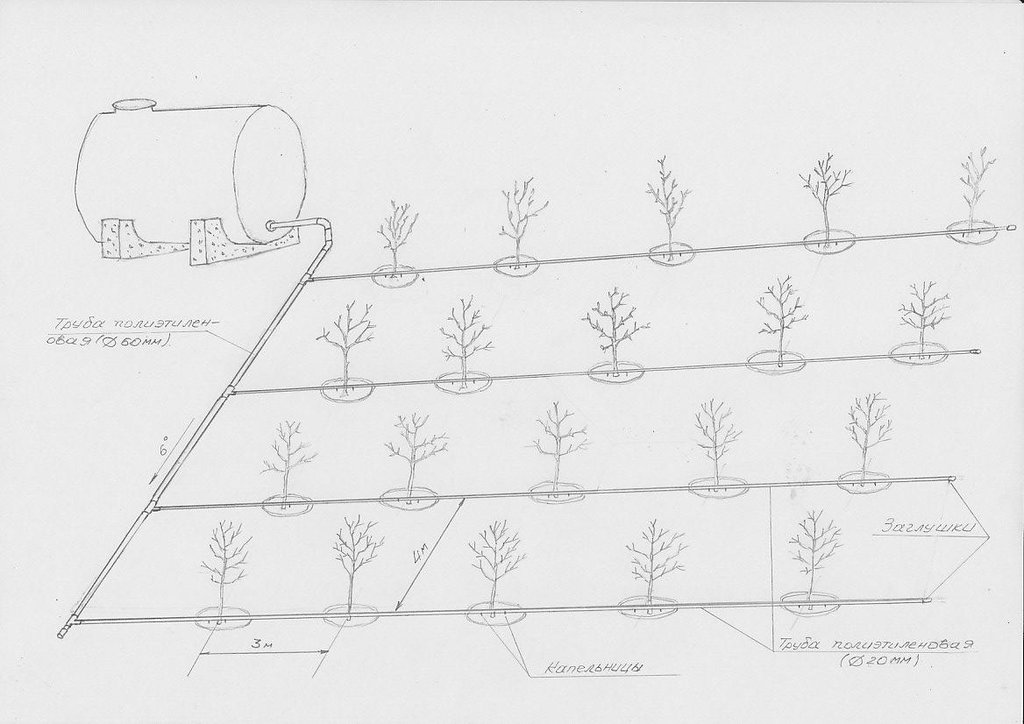Irrigation of orchards by using low cost drip irrigation technique [塔吉克斯坦]
- 创建:
- 更新:
- 编制者: Aslam Qadamov
- 编辑者: –
- 审查者: David Streiff, Alexandra Gavilano
Обёрикунии богхо бо истифода аз технологияи обзахиракунии камнарх
technologies_1452 - 塔吉克斯坦
- Irrigation of orchards by using low cost drip irrigation technique: March 14, 2017 (inactive)
- Irrigation of orchards by using low cost drip irrigation technique: July 19, 2017 (inactive)
- Irrigation of orchards by using low cost drip irrigation technique: Aug. 20, 2019 (inactive)
- Irrigation of orchards by using low cost drip irrigation technique: Nov. 2, 2021 (public)
查看章节
全部展开 全部收起1. 一般信息
1.2 参与该技术评估和文件编制的资源人员和机构的联系方式
SLM专业人员:
Abdulkodirov Adab
MSDSP Aga Khan Foundation
塔吉克斯坦
有助于对技术进行记录/评估的机构名称(如相关)
Pamir Biological Institute (Pamir Biological Institute) - 塔吉克斯坦有助于对技术进行记录/评估的机构名称(如相关)
Kyrgyzstan Mountain Societies Development Support Programme, Aga Khan Development Network (MSDSP KG) - 吉尔吉斯斯坦1.3 关于使用通过WOCAT记录的数据的条件
(现场)数据是什么时候汇编的?:
11/04/2011
编制者和关键资源人员接受有关使用通过WOCAT记录数据的条件。:
是
2. SLM技术的说明
2.1 技术简介
技术定义:
Irrigation of a young orchard using locally available and low-cost materials for a drip irrigation system in the Pamir’s arid zone
2.2 技术的详细说明
说明:
The system consists of a reservoir and polyethylene irrigation tubes and emitters installed along the rows of trees. Water accumulates in the reservoir during spring and early summer when there is no deficit in irrigation water. During the dry summer months water is then used for drip irrigation. Located in the upper part of the system, the reservoir ensures water pressure in the system. Due to the complex local topography, this irrigation method can be used without water pumps since natural water pressure ensures normal functioning of the system. Even though this water saving technology is quite effective, drip irrigation is rarely used since both the construction and maintenance of the system are quite expensive. With the introduction of this technology into the poor mountain communities of GBAO, the overall objective was to make drip irrigation technology cheaper and more easily available to farmers. The objective was achieved by the use of simple polyethylene irrigation tubes, simple screws instead of expensive emitters, and natural water pressure excluding the construction of a water pump station. Water is dripped directly to the roots of the trees, thus excluding loss of water and soil erosion. Fertilisers can be added directly to the water reservoir. This technology allows increased water savings of 50%, and 90% of fertilisers. During the growing period trees are watered once every 6 days.
Purpose of the Technology: The purpose of this technology is to improve the water supply for fruit orchards during the growing period in the arid conditions of the Pamirs where available water is very limited.
Establishment / maintenance activities and inputs: Steps to implement the technology include the following: dig holes for trees, plant trees, establish water reservoir, lay polyethylene tubes, install emitters and regularly clean irrigation system.
Natural / human environment: The plot is located in an arid zone at the height of 2000m above sea level. It is a high mountain area with typical brown soils and slopes up to 60 degrees steepness. Annual precipitation is quite low and mainly occurs in the autumn and winter period. Summers are extremely dry. The main occupations of the local population include agriculture and cattle breeding.
2.3 技术照片
2.5 已应用该技术的、本评估所涵盖的国家/地区/地点
国家:
塔吉克斯坦
区域/州/省:
GBAO
有关地点的进一步说明:
Shugnan
Map
×2.6 实施日期
如果不知道确切的年份,请说明大概的日期:
- 不到10年前(最近)
2.7 技术介绍
详细说明该技术是如何引入的:
- 通过项目/外部干预
注释(项目类型等):
the project was implemented in 2006
3. SLM技术的分类
3.1 该技术的主要目的
- adapt to enviroment
3.2 应用该技术的当前土地利用类型

农田
- 乔木与灌木的种植
主要农作物(经济作物及粮食作物):
major food crop: apple, apricot, walnut
注释:
Major land use problems (compiler’s opinion): lack of water, soil erosion, reduction of yield, reduction of soil fertility
Major land use problems (land users’ perception): lack of irrigation water, reduction of yield
Future (final) land use (after implementation of SLM Technology): Cropland: Ct: Tree and shrub cropping
如果由于技术的实施而导致土地用途发生变化,则在技术实施前说明土地利的用途。:
Cropland: Ct: Tree and shrub cropping
3.3 有关土地利用的更多信息
该技术所应用土地的供水:
- 充分灌溉
每年的生长季节数:
- 1
具体说明:
Longest growing period in days: 190Longest growing period from month to month: from April to October
3.4 该技术所属的SLM组
- 灌溉管理(包括供水、排水)
3.5 技术传播
具体说明该技术的分布:
- 均匀地分布在一个区域
如果该技术均匀地分布在一个区域上,请注明覆盖的大致区域。:
- < 0.1 平方千米(10 公顷)
注释:
0.01 ha
3.6 包含该技术的可持续土地管理措施

农艺措施
- A1:植被和土壤覆盖层

植物措施
- V1:乔木和灌木覆盖层

管理措施
- M4:活动时间安排的重大变化
注释:
Main measures: vegetative measures
Secondary measures: agronomic measures
Type of vegetative measures: aligned: -linear
3.7 该技术强调的主要土地退化类型

生物性退化
- Bc:植被覆盖的减少

水质恶化
- Ha:干旱化
注释:
Main type of degradation addressed: Bc: reduction of vegetation cover, Ha: aridification
Main causes of degradation: soil management, crop management (annual, perennial, tree/shrub), change in temperature, change of seasonal rainfall
Secondary causes of degradation: over abstraction / excessive withdrawal of water (for irrigation, industry, etc.), droughts, population pressure, poverty / wealth
3.8 防止、减少或恢复土地退化
具体数量名该技术与土地退化有关的目标:
- 防止土地退化
- 减少土地退化
注释:
Main goals: prevention of land degradation
Secondary goals: mitigation / reduction of land degradation, rehabilitation / reclamation of denuded land
4. 技术规范、实施活动、投入和成本
4.1 该技术的技术图纸
4.2 技术规范/技术图纸说明
The system consists of a reservoir and polyethylene irrigation tubes and emitters installed along the rows of trees.
Technical knowledge required for field staff / advisors: moderate
Technical knowledge required for land users: moderate
Main technical functions: stabilisation of soil (eg by tree roots against land slides), increase / maintain water stored in soil, water harvesting / increase water supply
Secondary technical functions: improvement of ground cover, increase in organic matter, increase in nutrient availability (supply, recycling,…), water spreading, increase of biomass (quantity), promotion of vegetation species and varieties (quality, eg palatable fodder)
Aligned: -linear
Vegetative material: F : fruit trees / shrubs
Number of plants per (ha): 400
Vertical interval between rows / strips / blocks (m): 1
Spacing between rows / strips / blocks (m): 3
Vertical interval within rows / strips / blocks (m): 3
Fruit trees / shrubs species: apricot, peach, european walnut, apple
Perennial crops species: alfalfa
Slope (which determines the spacing indicated above): 8.00%
4.3 有关投入和成本计算的一般信息
其它/国家货币(具体说明):
Tajik Somony
注明美元与当地货币的汇率(如相关):1美元=:
4.45
注明雇用劳工的每日平均工资成本:
3.00
4.4 技术建立活动
| 活动 | 措施类型 | 时间 | |
|---|---|---|---|
| 1. | tree planting | 植物性的 | first year |
| 2. | mounting of drip irrigation system | 植物性的 | before planting |
4.5 技术建立所需要的费用和投入
| 对投入进行具体说明 | 单位 | 数量 | 单位成本 | 每项投入的总成本 | 土地使用者承担的成本% | |
|---|---|---|---|---|---|---|
| 劳动力 | Tree planting | Persons/day | 2.0 | 11.0 | 22.0 | 100.0 |
| 劳动力 | Mounting of drip irrigation system | Persons/day | 5.0 | 25.2 | 126.0 | |
| 设备 | Tools | pieces | 5.0 | 1.2 | 6.0 | 100.0 |
| 设备 | Other Tools | pieces | 5.0 | 2.2 | 11.0 | |
| 设备 | Polyethylene tube | meters | 2200.0 | 0.445454545 | 980.0 | |
| 设备 | Watertank | pieces | 1.0 | 600.0 | 600.0 | |
| 植物材料 | Tree seedlings | pieces | 360.0 | 0.675 | 243.0 | 100.0 |
| 肥料和杀菌剂 | Fertilizer | kg | 10.0 | 1.7 | 17.0 | 100.0 |
| 技术建立所需总成本 | 2005.0 | |||||
注释:
Duration of establishment phase: 1 month(s)
4.6 维护/经常性活动
| 活动 | 措施类型 | 时间/频率 | |
|---|---|---|---|
| 1. | sanitary cutting of trees | 植物性的 | every 3-5 years |
| 2. | hay harvest | 植物性的 | three time per year |
| 3. | unclogging the irrigation tubes | 植物性的 | every year |
4.7 维护/经常性活动所需要的费用和投入(每年)
| 对投入进行具体说明 | 单位 | 数量 | 单位成本 | 每项投入的总成本 | 土地使用者承担的成本% | |
|---|---|---|---|---|---|---|
| 劳动力 | Sanitary cutting of trees | Persons/day | 0.6 | 16.66667 | 10.0 | 100.0 |
| 劳动力 | Hay harvest | Persons/day | 1.0 | 9.0 | 9.0 | 100.0 |
| 劳动力 | Unclogging the irrigation tubes | Persons/day | 1.0 | 11.0 | 11.0 | |
| 设备 | Tools (Scissors) | pieces | 2.0 | 2.5 | 5.0 | 100.0 |
| 设备 | Tool for harvesting | pieces | 1.0 | 2.0 | 2.0 | 100.0 |
| 设备 | Tools for unclogging tubes | pieces | 2.0 | 2.25 | 4.5 | 100.0 |
| 设备 | Polyethylene tube | meters | 56.0 | 0.445454545 | 24.95 | 100.0 |
| 设备 | Water tank | repair | 1.0 | 10.0 | 10.0 | 100.0 |
| 植物材料 | Seedlings tree replacement | pieces | 15.0 | 0.675 | 10.13 | 100.0 |
| 肥料和杀菌剂 | Fertilizer | kg | 10.0 | 1.7 | 17.0 | 100.0 |
| 技术维护所需总成本 | 103.58 | |||||
注释:
For creation of drip irrigation system on a plot of 1 ha (May 2011)
4.8 影响成本的最重要因素
描述影响成本的最决定性因素:
equipment for irrigation system (polyethylene tubes)
5. 自然和人文环境
5.1 气候
年降雨量
- < 250毫米
- 251-500毫米
- 501-750毫米
- 751-1,000毫米
- 1,001-1,500毫米
- 1,501-2,000毫米
- 2,001-3,000毫米
- 3,001-4,000毫米
- > 4,000毫米
有关降雨的规范/注释:
260mm per year, winter summer rains. Length of dry period is about 120 days.
农业气候带
- 干旱
Thermal climate class: temperate. 2 mounth below 5°C and 6 mounth above 10°C
5.2 地形
平均坡度:
- 水平(0-2%)
- 缓降(3-5%)
- 平缓(6-10%)
- 滚坡(11-15%)
- 崎岖(16-30%)
- 陡峭(31-60%)
- 非常陡峭(>60%)
地形:
- 高原/平原
- 山脊
- 山坡
- 山地斜坡
- 麓坡
- 谷底
垂直分布带:
- 0-100 m a.s.l.
- 101-500 m a.s.l.
- 501-1,000 m a.s.l.
- 1,001-1,500 m a.s.l.
- 1,501-2,000 m a.s.l.
- 2,001-2,500 m a.s.l.
- 2,501-3,000 m a.s.l.
- 3,001-4,000 m a.s.l.
- > 4,000 m a.s.l.
关于地形的注释和进一步规范:
Altitudinal zone is 2100m above sea level
5.3 土壤
平均土层深度:
- 非常浅(0-20厘米)
- 浅(21-50厘米)
- 中等深度(51-80厘米)
- 深(81-120厘米)
- 非常深(> 120厘米)
土壤质地(表土):
- 中粒(壤土、粉土)
表土有机质:
- 低(<1%)
如有可能,附上完整的土壤描述或具体说明可用的信息,例如土壤类型、土壤酸碱度、阳离子交换能力、氮、盐度等。:
Soil texture is about 40% silt
Soil fertility is medium
Soil drainage / infiltration is good
Soil water storage capacity is medium
5.4 水资源可用性和质量
地下水位表:
< 5米
地表水的可用性:
中等
水质(未处理):
良好饮用水
5.5 生物多样性
物种多样性:
- 中等
5.6 应用该技术的土地使用者的特征
生产系统的市场定位:
- 生计(自给)
- 商业/市场
非农收入:
- 收入的10-50%
相对财富水平:
- 贫瘠
- 平均水平
个人或集体:
- 个人/家庭
机械化水平:
- 手工作业
性别:
- 女人
- 男人
说明土地使用者的其他有关特征:
Land users applying the Technology are mainly common / average land users
Population density: 10-50 persons/km2
Annual population growth: 0.5% - 1%
40% of the land users are average wealthy and own 30% of the land.
60% of the land users are poor and own 70% of the land.
Off-farm income specification: In dry season the harvest is about 20 - 30% higher as compared with the farmers which did not use the technology
5.7 应用该技术的土地使用者拥有或租用的平均土地面积
- < 0.5 公顷
- 0.5-1 公顷
- 1-2 公顷
- 2-5公顷
- 5-15公顷
- 15-50公顷
- 50-100公顷
- 100-500公顷
- 500-1,000公顷
- 1,000-10,000公顷
- > 10,000公顷
这被认为是小规模、中规模还是大规模的(参照当地实际情况)?:
- 小规模的
5.8 土地所有权、土地使用权和水使用权
土地所有权:
- 社区/村庄
土地使用权:
- 个人
用水权:
- 社区(有组织)
5.9 进入服务和基础设施的通道
健康:
- 贫瘠
- 适度的
- 好
教育:
- 贫瘠
- 适度的
- 好
技术援助:
- 贫瘠
- 适度的
- 好
就业(例如非农):
- 贫瘠
- 适度的
- 好
市场:
- 贫瘠
- 适度的
- 好
能源:
- 贫瘠
- 适度的
- 好
道路和交通:
- 贫瘠
- 适度的
- 好
饮用水和卫生设施:
- 贫瘠
- 适度的
- 好
金融服务:
- 贫瘠
- 适度的
- 好
6. 影响和结论性说明
6.1 该技术的现场影响
社会经济效应
生产
作物生产
SLM之前的数量:
45kg per ha
SLM之后的数量:
80kg per ha
注释/具体说明:
water availability increase production of fruits
饲料生产
SLM之前的数量:
5 centner/ha
SLM之后的数量:
20 centner/ha
注释/具体说明:
grass between rows used for fodder
饲料质量
SLM之前的数量:
bad
SLM之后的数量:
high
注释/具体说明:
before natural grass - after alfa alfa
畜牧生产
SLM之前的数量:
2- 5per hose
SLM之后的数量:
6-15 per hose
注释/具体说明:
increase of fodder production stimulate livestock development
木材生产
SLM之前的数量:
0.5 m3/hose
SLM之后的数量:
1-5m3/hose
注释/具体说明:
sanitary cutting of tress
生产故障风险
SLM之前的数量:
0
SLM之后的数量:
100%
注释/具体说明:
increased water availability
生产区域
SLM之前的数量:
10%
SLM之后的数量:
70%
注释/具体说明:
technology helps to use steep slopes
收入和成本
农业投入费用
SLM之前的数量:
0
SLM之后的数量:
50%
农业收入
SLM之前的数量:
10%
SLM之后的数量:
80%
注释/具体说明:
increased harvest
社会文化影响
食品安全/自给自足
SLM之前的数量:
0
冲突缓解
SLM之前的数量:
50%
SLM之后的数量:
0%
注释/具体说明:
decreased conflict related to irrigation water use
社会经济弱势群体的情况
SLM之前的数量:
0
SLM之后的数量:
50%
注释/具体说明:
increased incomes of poor farmers
Livelihoods and human well-being
注释/具体说明:
After the implementation of the technology the households were protected from negative influence of dry season.
生态影响
水循环/径流
水量
SLM之前的数量:
10%
SLM之后的数量:
60%
水的回收/收集
SLM之前的数量:
0%
SLM之后的数量:
100%
地表径流
SLM之前的数量:
100%
SLM之后的数量:
0%
注释/具体说明:
all the water can be absorbed by soil
蒸发
SLM之前的数量:
0
SLM之后的数量:
10%
注释/具体说明:
transpiration of trees and grass
土壤
土壤水分
SLM之前的数量:
0%
SLM之后的数量:
80%
注释/具体说明:
during the dry season
土壤覆盖层
SLM之前的数量:
0%
SLM之后的数量:
20%
土壤流失
土壤结壳/密封
土壤压实
生物多样性:植被、动物
生物量/地上C
植物多样性
栖息地多样性
其它生态影响
Hazards towards adverse events
SLM之前的数量:
0%
SLM之后的数量:
100%
注释/具体说明:
reduced dry season effect
6.2 该技术的场外影响已经显现
水资源可用性
SLM之前的数量:
0%
SLM之后的数量:
50%
6.3 技术对渐变气候以及与气候相关的极端情况/灾害的暴露和敏感性(土地使用者认为的极端情况/灾害)
渐变气候
渐变气候
| 季节 | 气候变化/极端天气的类型 | 该技术是如何应对的? | |
|---|---|---|---|
| 年温度 | 增加 | 好 |
气候有关的极端情况(灾害)
气象灾害
| 该技术是如何应对的? | |
|---|---|
| 局地暴雨 | 好 |
| 局地风暴 | 好 |
气候灾害
| 该技术是如何应对的? | |
|---|---|
| 干旱 | 不好 |
水文灾害
| 该技术是如何应对的? | |
|---|---|
| 比较和缓的(河道)洪水 | 不好 |
其他气候相关的后果
其他气候相关的后果
| 该技术是如何应对的? | |
|---|---|
| 缩短生长期 | 好 |
6.4 成本效益分析
技术收益与技术建立成本相比如何(从土地使用者的角度看)?
短期回报:
轻度消极
长期回报:
积极
技术收益与技术维护成本/经常性成本相比如何(从土地使用者的角度看)?
短期回报:
中性/平衡
长期回报:
积极
注释:
Increase of irrigation water availability will improve agricultural production and cover all the expenses that were needed for the establishment of the irrigation system
6.5 技术采用
- 大于 50%
如若可行,进行量化(住户数量和/或覆盖面积):
18 households (area is 10 ha)
在所有采用这项技术的人当中,有多少人是自发地采用该技术,即未获得任何物质奖励/付款?:
- 10-50%
注释:
80% of land user families have adopted the Technology with external material support
15 land user families have adopted the Technology with external material support
20% of land user families have adopted the Technology without any external material support
3 land user families have adopted the Technology without any external material support
There is a little trend towards spontaneous adoption of the Technology
Comments on adoption trend: some land users have already adopted the system
6.7 该技术的优点/长处/机会
| 土地使用者眼中的长处/优势/机会 |
|---|
| Increase water resources for irrigation of orchards |
| 编制者或其他关键资源人员认为的长处/优势/机会 |
|---|
| Increases water saving up to 50% |
| Opportunity to irrigate orchards during droughts and dry spells (when there is no irrigation water available) |
| Opportunity to apply this technology on steep slopes |
|
Reservoir can be filled with rainwater How can they be sustained / enhanced? through installation of rainwater harvesting system |
6.8 技术的弱点/缺点/风险及其克服方法
| 编制者或其他关键资源人员认为的弱点/缺点/风险 | 如何克服它们? |
|---|---|
| The system has to be regularly cleaned from sediments | use filters to clean water from sediments |
链接和模块
全部展开 全部收起链接
无链接
模块
无模块






